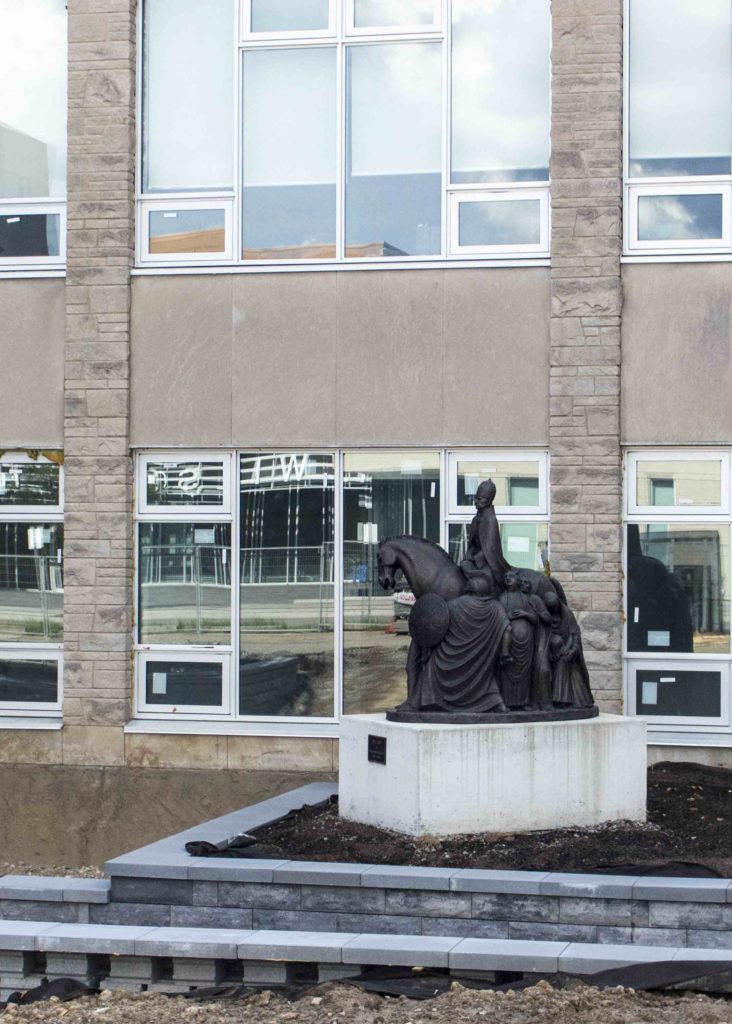Welcome back, Pope Leo 1! We have spent almost a year with our beautiful statue covered in plywood for protection, but now that we are finishing up the entrance and thinking about landscaping, it was time to let Pope Leo greet us again! For those of you wondering why we would have statue of a Pope adorning the entrance of a historically Baptist and protestant seminary and graduate school, please read the speech that Dr Stanley Porter gave when we unveiled the statue below.

February 13, 2017
Pope Leo I “the Great” (St. Leo) Statue Dedication
We are dedicating this statue as a visual and clear expression of the continuing importance of orthodox Christian belief, which is the foundation of genuine pastoral and ecclesial concern and practice.
Some of you may be wondering how a statue of a Roman Catholic pope came to be installed on the grounds of a historically Baptist theological seminary, and on the eve of the 500th anniversary of the Protestant Reformation no less. Well, let me assure you that we are not experiencing some confusion as to our own history or identity. In fact, there are several reasons why it is entirely appropriate for such a beautiful work of art as this to adorn our campus. A few biographical details about St. Leo’s life and ministry should provide some helpful context.
The details about Leo’s early life and ministry are scattered, but a basic sketch can be pieced together from historical sources. St. Leo was born in around the year 400 to a well-to-do Roman family, and was raised in the Tuscany region of Italy. By the time he was about 30 years of age, Leo had been appointed as a deacon in the church. He worked together with the church father Cyril of Alexandria in drawing on the doctrinal influence of the Roman church to help settle ecclesiastical controversies, and was himself eventually selected to serve as the bishop of Rome on September 29th, 440. He held this position until his death in the year 461.
Throughout his life in ministry, St. Leo was known to possess a real talent for negotiating and settling hostilities between opposing factions. For instance, Leo was sent by the Emperor Valentinian III to the region of Gaul to settle an ongoing dispute between a certain magistrate and military commanders stationed in that region. In the year 452, Leo also famously was sent as part of a delegation to confront the warlord Attila the Hun, and led the way in negotiating a treaty with him so that he would not invade the city of Rome. Given Attila’s reputation for brutality, it is a certainty that Leo’s courageous act saved the lives of many thousands of people and in fact changed the course of history.
With regard to his lasting contributions to the church, St. Leo took great interest in promoting Trinitarian theology and Christological orthodoxy. For instance, he appointed John Cassian to write an important theological treatise addressing issues related to the Nestorian controversy. Leo himself was also an accomplished letter writer and preacher. He wrote and preached sermons on the nature of Christ’s presence in the church, and the role of faith, Scripture, church tradition, and the sacraments. In addition to his ecclesiological writings, Leo also wrote theological treatises on the divine and human natures of Christ, including the famous “Tome of Leo,” the 28th in his collection of letters.
Leo is probably best known for playing an influential role in the Council of Chalcedon (AD 451), which focused primarily on issues related to the two natures of Christ (known as “the hypostatic union”). This council asserted that the divine and human natures are united in the person of Jesus Christ “with neither confusion nor division.” The Chalcedonian Creed afterwards became a foundational doctrinal expression of Christian belief in the divine-human nature of Jesus Christ, and it remains so to this day.
St. Leo is heralded in the Roman Catholic tradition as having been a great pope. However, Leo’s legacy extends well beyond the Roman Catholic Church to the rest of Christianity as well, including those of us in the Protestant tradition. Leo was a pastor who worked tirelessly for his people and who fought for Christian unity in orthodoxy. He remains an example which should be inspiring to us all.

